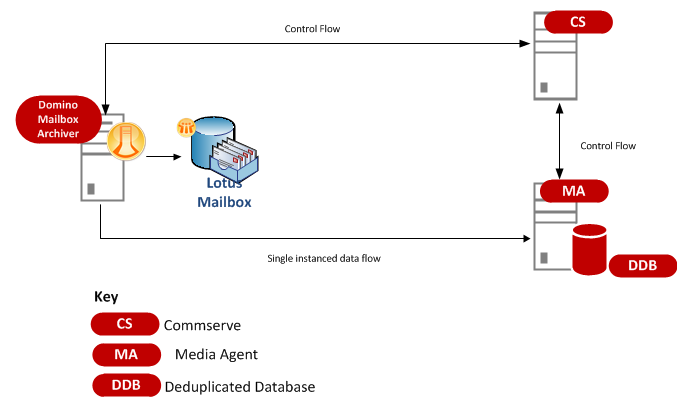Introduction
Domino Mailbox Archiver agent provides a seamless vehicle for moving old or infrequently used mailbox items to secondary storage. In doing so, costs are saved by freeing up primary disk space, and end-user mailboxes become easier to manage. Added options of Client Add-In integration and compliance archiving help ensure all archived Domino data is easily traceable and retrievable whenever the need arises.
The archived messages are available for quick and easy retrieval to administrators and end users. This integrated agent is also able to selectively age off stubs to reclaim space on the primary storage based on the pruning parameters.

Key Features
Dedicated Data Protection Modes
Domino Mailbox Archiver agent operates in 3 different Modes:
Backup , Archive and Backfill, to protect messages in the journaling mail box, individual mail databases stored on the Domino and the mail databases archived by end-user on their workstation, but stored on Domino (local nsf).
Granular Archiving Criteria
You can configure archiving rules that allow you to archive the mailbox messages based on various criteria like mailbox quota, attachments, mail size etc.
Granular Recovery
Archived data can be browsed to granular level to recover data by selecting required emails to restore.
Archiving Scenarios
The Domino Mailbox Archiver Agent provides support for two distinct archiving scenarios:
Migration Archiving, which is useful if you want to reduce the size of messages routinely backed up to primary storage by the Domino iDataAgent.
Compliance Archiving, which is useful if you want to index messages copied to the journaling mailbox to meet security and compliance standards.
These archiving scenarios are further contrasted in the following table:
|
Migration Archiving |
Compliance Archiving |
|---|---|
|
Domino Mailbox Archiver Agent with Migration-only configurations set |
Domino Mailbox Archiver Agent with Migration and Compliance configurations set |
|
Message content is moved from the source mailbox to the designated secondary storage location, leaving only the message header and a corresponding stub icon. Users can later recover the original message contents by double-clicking the stub icon. |
Messages copied to the Domino journaling mailbox are moved to the designated secondary storage location. Only authorized users may retrieve messages archived from the journaling mailbox. Client mailbox copies of archived messages remain intact within their respective client mailboxes. |
|
Primary storage resources and data protection operation time used by the Domino iDataAgent are reduced. |
Messages are archived securely with no impact on the source mailboxes or databases. |
|
Messages may be recovered in-place (i.e., to the source mailbox) or out-of-place (i.e., to another mailbox). |
Messages are retrieved out-of-place (i.e., to a secure mailbox created exclusively for compliance purposes). |
Terminology
An Domino can be set up and organized in a number of ways. It is important to understand this organization to create an effective archive plan.
The following sections describe the main components that comprise a typical Domino. Note that the Domino Mailbox Archiver Agent is only supported for Notes mailboxes.
Notes Partitions
A Notes partition is an instance of Domino running on a given computer. Domino may be installed multiple instances on the same computer, each instance, or partition, acting as an individual server. For example, instance1 on computer A is running a simple Notes database. Instance 2 also on computer A runs Domino web server database. For more information, refer to Configuring Domino Partitions.
Notes Data Paths
Each partition of Domino will have a data path pointing to the location of the database files, typically the notes.ini file. Databases existing outside of the data path can be linked to the primary data path.
Notes Links and Link files
A Notes link is a pointer to a database outside of the data path for a given partition. A Notes link file is a text file that contains the path or paths of those databases. There are two types of Notes link files, database link files and folder link files. A database link is a .nsf file containing the path of a single database. A folder link is a .dir file containing a path or paths to multiple databases.
Data Documents
Data documents are the documents saved in Notes Database.
Binary Paths
Domino binary path is the location that Domino places binary files. If users have multiple instances on one sever, all instances are sharing the same binary path.